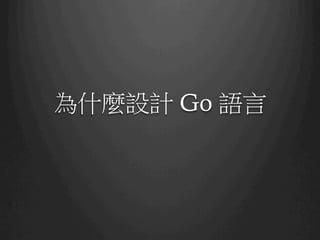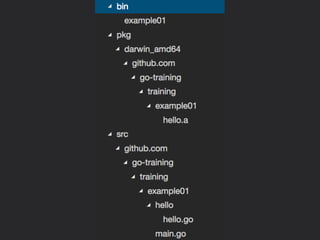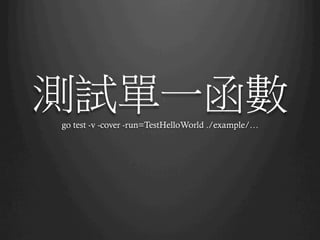Introduction to Golang final
- 1. 一天學會 Go 語言 2017.03.18 吳柏毅 Bo-Yi Wu
- 2. Blog: https://blog.wu-boy.com/ GitHub: http://github.com/appleboy Slide: https://www.slideshare.net/appleboy
- 3. 課程大綱 Go 基本簡介 Go 環境建置 Go 基本語法 Go concurrency 介紹 Go 簡易 HTTP 伺服器 Go 簡易 Command Line 實作 Go 搭配 Docker 介紹 Go 結合 C 語⾔言 Go 實作 Line, Facebook 機器人
- 4. 課程大綱 Go 基本簡介 Go 環境建置 Go 基本語法 Go concurrency 介紹 Go 簡易 HTTP 伺服器 Go 簡易 Command Line 實作 Go 搭配 Docker 介紹 Go 結合 C 語⾔言 Go 實作 Line, Facebook 機器人
- 5. Go 基本簡介 Go 語言誕生 Go 語言優勢 Go 語言選擇 誰在用 Go 語言
- 6. Robert Griesemer, Rob Pike 和 Ken Thompson
- 7. Go 發布週期(半年一版) 2013/05 1.1 2013/12 1.2 2014/06 1.3 2014/12 1.4 2015/08 1.5 (Google 規定以後每半年發佈一版) 2016/02 1.6 2016/08 1.7 2017/02 1.8
- 8. 為什麼設計 Go 語言
- 9. Google 遇到的問題 大量的 C++ 代码,同時引入 Java 和 Python 成千上萬的工程师 數百萬的程式碼 分散式編譯系統 數百萬的伺服器
- 10. Google 痛點 編譯非常慢 沒用的相依性檔案 工程師只用了一個語言一小部分 程式碼難以維護 (可讀性差,⽂文件不清楚) 部署時間越來越長 交叉編譯困難
- 11. Go 語言特性 沒有物件導向 (無繼承特性) 強制類型 Function 和 Method 没有錯誤處理 ⽤用字⾸首來區別可否存取 不⽤用的 Import 或變數會引起編譯錯誤 完整的標準函式 支援 UTF-8 格式
- 12. Go at Google: Language Design in the Service of Software Engineering https://talks.golang.org/2012/splash.article
- 13. 為什麼要導入 Go 語言 Team work
- 14. Go 帶給團隊優勢 學習曲線 開發及執行效率 由 Google 維護 部署方便 跨平台編譯 內建 Coding Style, Testing 等工具 多核心處理
- 15. 誰在用 Go 語言
- 31. Switched from other languages. PHP, Python, Node.js, Java, C++ https://github.com/golang/go/wiki/FromXToGo
- 32. 如何將 Go 語言導入團隊
- 33. 學習曲線 程式碼簡潔 沒有物件導向 團隊開發工具整合 Coding Style Testing Tool Benchmark Tool 性能分析 部署環境 降低部署時間 降低測試時間 重啟時間非常快,Load-Balancer 不需要 Pre-warning 系統效能 (記憶體用量, CPU 使用率 …) EC2 使用量降低
- 34. A push notification server written in Go https://github.com/appleboy/gorush/
- 35. 課程大綱 Go 基本簡介 Go 環境建置 Go 基本語法 Go concurrency 介紹 Go 簡易 HTTP 伺服器 Go 簡易 Command Line 實作 Go 搭配 Docker 介紹 Go 結合 C 語⾔言 Go 實作 Line, Facebook 機器人
- 36. 安裝 Go 環境 請直接安裝 Go Version Manager https://github.com/moovweb/gvm
- 37. 安裝步驟 gvm install go1.4 -B gvm use go1.4 export GOROOT_BOOTSTRAP=$GOROOT gvm install go1.8
- 38. 請在終端機執行 go env
- 40. 修改 GOPATH 路徑 export GOPATH=/Users/appleboy/git/go 注意: Go 1.8 之後已經預設將 GOPATH 設定在 ${HOME}/go 路徑
- 43. Go 指令介紹 go get go run go test go fmt go install go build go doc
- 44. 在本機端看 Go 文件 godoc –http=:8088
- 45. Go 程式碼品質
- 47. gofmt 程式碼自動化排版 整合各大編輯器 (Atom, Sublime, VS code, Vim .. 等) 重構程式碼
- 50. Go 編輯器 Visual Studio Code https://code.visualstudio.com
- 51. 課程大綱 Go 基本簡介 Go 環境建置 Go 基本語法 Go 套件製作 Go concurrency 介紹 Go 簡易 Command Line 實作 Go 搭配 Docker 介紹 Go 結合 C 語⾔言 Go 實作 Line, Facebook 機器人
- 54. Import 順序 內建 Package 自建 Package 外部 Package
- 59. 變數宣告 使用 const 使用 := (常用) 使用 var
- 60. const使用 iota
- 61. if 條件子句
- 62. if 條件子句 右括號必須跟 if 或 else 同一行 支援私有變數,只在 if 內使用
- 63. switch 不需要寫 break fallthrough 可以繼續執⾏行下⼀一個 case
- 64. Array, Slice
- 65. Functions
- 66. function Return Return naming Return multiple
- 67. 作業 請寫出一個 func 加總所有輸入值及平均值 Func(4,6) = 10, 5 Func(4,6,10) = 20, 6.66 請忽略負數值 Func(4, -2, 100) = 104, 34
- 68. Variadic Functions Go func 不提供預設值
- 69. Structs, Methods
- 70. 作業 實作計算機功能 初始值 New(int) 加法 func Add(input …int) 減法 func Sub(input …int) 輸出
- 71. Interface
- 72. 作業 實作兩台計算機功能 初始值(一台為 100, 一台為 200) 加法(一台 * 2, 一台 * 3) 減法(一台 * 2, 一台 * 4) 輸出 Add(100,200,300) Sub(50, 60) 計算機 1: 輸出為 1080 計算機 2: 輸出為 1560
- 73. Type assertion and type switch Interface
- 74. 作業 請用單一 func 實作底下功能 輸入數字 100 轉換成字串 100 輸入字串 100 轉換成數字 100
- 75. init function
- 79. 作業 撰寫底下 func 功能 輸入數字小於 10 則回傳錯誤 自訂錯誤輸入訊息 您的輸入 %d 小於 10
- 80. Vendor 管理
- 83. Go 也想統一 dependency tool https://github.com/golang/dep
- 84. 寫測試Go 內建測試 Tool
- 85. 測試完整 package go test -v -cover -coverprofile=coverage.txt ./…
- 86. 測試單一函數go test -v -cover -run=TestHelloWorld ./example/…
- 87. 測試覆蓋率報表 go tool cover -html=coverage.txt
- 89. 作業 請將前面作業補上基本測試,覆蓋率達 80 %
- 90. 課程大綱 Go 基本簡介 Go 環境建置 Go 基本語法 Go concurrency 介紹 Go 簡易 HTTP 伺服器 Go 簡易 Command Line 實作 Go 搭配 Docker 介紹 Go 結合 C 語⾔言 Go 實作 Line, Facebook 機器人
- 91. Go supports concurrency concurrent execution (goroutines) synchronization and messaging (channels) multi-way concurrent control (select)
- 94. sync.WaitGroup
- 95. Select
- 96. 作業 建立兩個 Channel errChannel := make(chan error, 1) finished := make(chan bool, 1) 用 For 跑 10 個 Job 其中第五個 Job 回傳 err chan 後結束程式 跑完 10 個 Job 則回傳 finished chan 後結束程式 用 sync.WaitGroup 實現
- 97. 課程大綱 Go 基本簡介 Go 環境建置 Go 基本語法 Go Concurrency 介紹 Go 簡易 HTTP 伺服器 Go 簡易 Command Line 實作 Go 搭配 Docker 介紹 Go 結合 C 語⾔言 Go 實作 Line, Facebook 機器人
- 100. HandleFunc
- 102. 自訂 Http.Server
- 103. 作業 撰寫 Http Server Listen on 8088 port /hello 輸出 Hello Golang
- 104. Go 1.8 Closed Server os.Signal
- 106. Gin, Beego, Echo …
- 112. 課程大綱 Go 基本簡介 Go 環境建置 Go 基本語法 Go concurrency 介紹 Go 簡易 HTTP 伺服器 Go 簡易 Command Line 實作 Go 搭配 Docker 介紹 Go 結合 C 語⾔言 Go 實作 Line, Facebook 機器人
- 117. 跨平台編譯 GOOS=linux GOARCH=amd64 CGO_ENABLED=0 go build -o hello package GOOS=linux GOARCH=arm CGO_ENABLED=0 go build -o hello package GOOS=windows GOARCH=amd64 CGO_ENABLED=0 go build -o hello package GOOS=darwin GOARCH=amd64 CGO_ENABLED=0 go build -o hello.exe package
- 118. Go cross compile tool https://github.com/mitchellh/gox
- 120. 課程大綱 Go 基本簡介 Go 環境建置 Go 基本語法 Go concurrency 介紹 Go 簡易 HTTP 伺服器 Go 簡易 Command Line 實作 Go 搭配 Docker 介紹 Go 結合 C 語⾔言 Go 實作 Line, Facebook 機器人
- 122. Docker Image docker build -t example-alpine -f Dockerfile.golang .
- 124. Alpine Linux 挑戰最小 docker image OS https://goo.gl/bLd9FA
- 125. golang:1.8.0-alpine
- 126. 更小 scratch
- 128. x509: failed to load system roots and no roots provided
- 129. centurylink/ca-certs
- 130. 課程大綱 Go 基本簡介 Go 環境建置 Go 基本語法 Go concurrency 介紹 Go 簡易 HTTP 伺服器 Go 簡易 Command Line 實作 Go 搭配 Docker 介紹 Go 結合 C 語⾔言 Go 實作 Line, Facebook 機器人
- 131. Downsize go binary? Go 1.5
- 132. Using shared library in Go this feature is available on linux/amd64 platform
- 133. Compile standard builtin packages go install -buildmode=shared -linkshared std
- 134. Compile your share library go install -buildmode=shared –linkshared calc
- 135. Using shared Go library in C
- 136. Go functions can be executed from C applications. //export <your_function_name> go build -buildmode=c-shared –o hello.so hello.go
- 137. buildmode=plugin go build -buildmode=plugin -o hello.so hello.go Go 1.8 feature
- 138. Using C Library in Go
- 139. 課程大綱 Go 基本簡介 Go 環境建置 Go 基本語法 Go concurrency 介紹 Go 簡易 HTTP 伺服器 Go 簡易 Command Line 實作 Go 搭配 Docker 介紹 Go 結合 C 語⾔言 Go 實作 Line, Facebook 機器人 (作業)
- 140. Bot 機器人 Slack Facebook Line Telegram
- 141. 作業 整合 Go Cli Tool: ./main server 用來接受 fb 或 line callback ./main send 用來傳送訊息給單一使用者 ./main send -u user -m message













































































































































